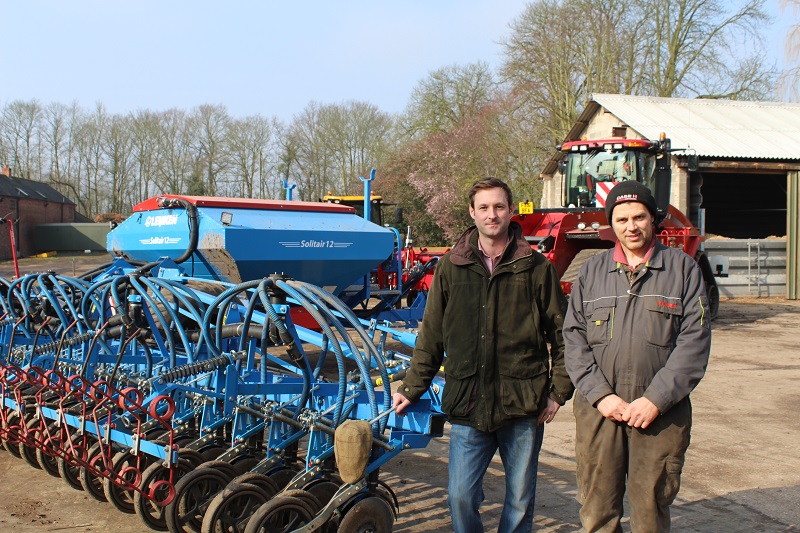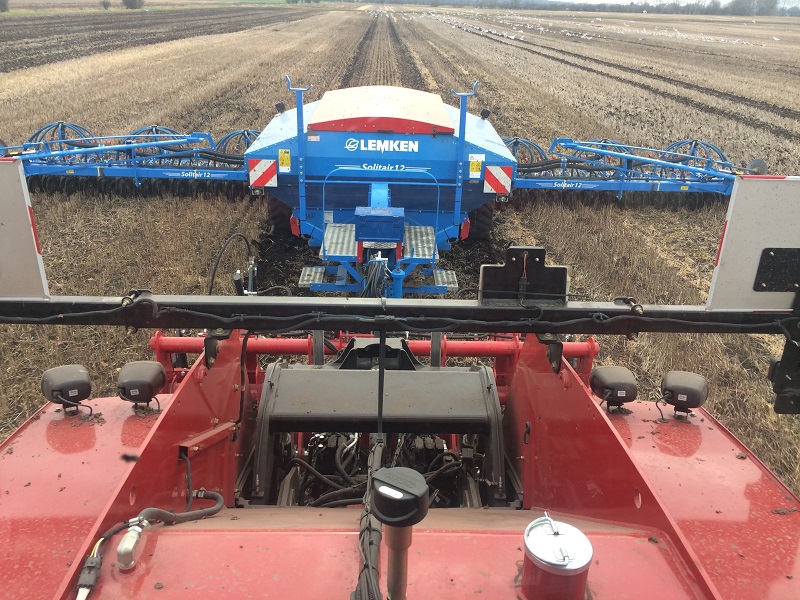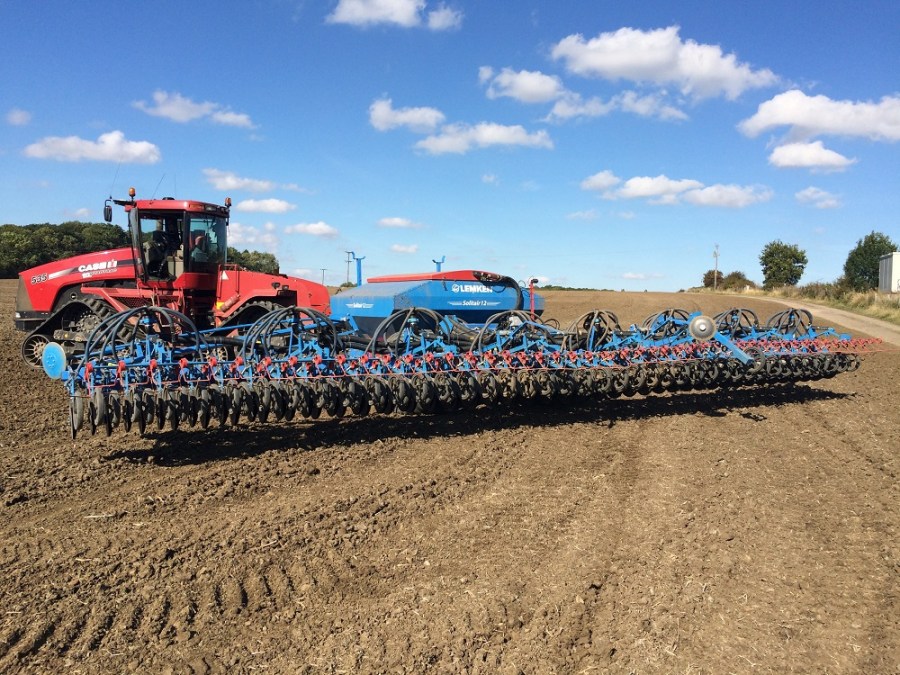Low-disturbance drilling is being hailed as a wonder technique for tackling blackgrass and improving soil structure. CPM finds out if a Notts grower’s 12m Lemken Solitair drill is delivering the goods.
You can already see improvements in the soil structure from adding in more organic material and restricting traffic to the tramlines.
By Ted Fleetwood
After years of beating his soils into shape with a series of heavy cultivation kit, Notts farmer Harry Barton decided to explore a lower disturbance method of crop establishment.
In his old regime, the farm’s predominantly medium clay loam soils were first ripped up with a 7m Simba SL to a depth of around 30cm. This opened up the soil structure, but also brought up plenty of lumps that then had to be knocked into a seedbed using a 12m Väderstad Carrier and a set of 24m Cambridge rolls.
It also often required a couple of passes with said combination before the seedbed was fit enough for the farm’s 8m

Harry Barton (left) and drill operator Rick Woods wanted a low disturbance drill that was wide enough to cover the cropping area and capable of direct drilling.
Horsch Sprinter tine drill to come in. Despite being a tad labour intensive, the system worked and yields were good.
However, concerns over declining soil condition and a growing blackgrass problem meant it was time for a change.
“We were spending so much time and money deep working the ground and then trying to get a decent seedbed,” says Harry Barton. “Meanwhile, it was making our blackgrass problem worse and it wasn’t doing our soil structure any favours either.”
Shallow cultivation
So for the 2015/16 season he decided to implement a new strategy of shallow cultivation and low disturbance drilling, combined with a CTF (Controlled Traffic Farming) system to reduce the impact of compaction from his heavy machinery. He also opted to up his spring cropping area in a bid to further hamper blackgrass.
The first step was to sell the Simba SL and Horsch Sprinter and leave primary cultivations in the hands of the Väderstad Carrier.
The plan was to use this to shallow cultivate straight behind the combine – this would both provide ideal conditions for a blackgrass chit before drilling as well as loosen the topsoil to make conditions easier for the drill to work.

The farm’s recently adopted a 12m CTF system, which should help improve soil condition.
He also wanted to direct drill crops on some of his lighter ground and gradually expand the area as the condition of his soils improved and they became easier to work.
Next Harry Barton went in search of a low disturbance drill that was both wide enough so he could cover his 1500ha cropping area and was capable of doing some direct drilling when required.
“At the time I started looking, there were a few drills on the market that fitted our requirements, but we ended up going for the Lemken as it was relatively lightweight compared with the competition,” he says.
So a deal was done on the 12m drill – with local dealer Marsh Seward at Markam Moor, Notts – and it was set to be delivered just in time for the autumn 2015 drilling campaign.
As standard, the Solitair comes with a 5800-litre hopper, a hydraulically driven fan feeding eight seed distribution heads and a folding 12m seed bar with 96 independently mounted double-disc coulters.
These are bolted on a parallel linkage to help with contour following and as standard come with one spring to control coulter pressure.
“One of our slight concerns was that the drill isn’t really designed for direct drilling and we were worried that the single spring wouldn’t give us enough coulter pressure to get the discs to dig into unworked ground,” says Harry Barton.
“However, Lemken offered us the option to upgrade to double springs on each assembly, which so far has had the desired effect.”
After the drill arrived on farm, it was first put to work establishing winter oilseed rape. Most crops were planted into ground that had been worked with the Väderstad Carrier, but they also direct drilled 46ha into a wheat stubble on some of the heavy clay loam ground as a trial.
Both crops established well and there were no problems getting the drill to penetrate into the fairly stiff unworked ground. But the most interesting trend was that flea beetle pressure was significantly lower in the direct-drilled crop, he says. “I’ve heard a couple of theories for why this might have happened, but I’m not sure which, if either, is correct” says Harry Barton.
“One is that the low disturbance drill doesn’t interfere with flea beetle predators so they control the numbers, and the other is that the standing stubble potentially hampers the movement of flea beetles.”
The rest of the winter cereal crops were planted into ground prepared with one or two passes of either the Väderstad Carrier or a Väderstad NZA that had been extended to 12.3m.
“We started drilling late to give the pre-emergence chemicals a longer effective working window on the blackgrass, but made good progress and somehow managed to finish around the same time as last year.”
It’s still a little early to see the impact the new system is having on blackgrass populations, but it definitely seems as though less is germinating in the crop after planting, he says.
“The results we’ve had so far are encouraging, but we’ll have to wait and see how much of a difference the drill has made as the season progresses,” he says. “It’s also as much about the changes we’ve made to our whole system, rather than the just the drill itself.”
Another of the drill’s autumn duties was to plant cover crops into OSR stubbles that would provide ground cover until spring, says Harry Barton. This is part of an Agrovista trail called Project Lamport that the farm has been involved in for the past couple of years.
“It’s partly looking at using cover crops and low-disturbance drilling to reduce blackgrass pressure. But the cover crops also have the added benefit of providing valuable organic matter to help make our soils more friable. The root structures should also help open up the soil for us without the need to cultivate at depth,” he adds.
Building up soil organic matter is another part of Harry Barton’s plan to improve soil health and fertility on the farm and increase his direct drilling area.
As part of the new system he’s been bringing in large amounts of organic material. This includes farmyard manure from a couple of muck-for-straw deals as well as imported sewage cake from Severn Trent and some locally sourced chicken manure. Since using this, he hasn’t had to apply any potash (MOP) or phosphate (TSP) and he’s already seen an improvement in soil workability.
“Because we’re only working the muck into the top few inches of soil the nutrients are there exactly where the plant needs them,” he says. “It makes me wince when I see people ploughing all those nutrients into the bottom of a furrow.”
The farm’s recently adopted a 12m CTF system, with everything from the cultivators to the combine now working at 12m (or multiples of this in the case of the sprayer). This should help improve soil condition further, he reckons.
All machines are guided by mobile VRS (virtual reference station) RTK (real-time kinetic) signal and everything sits on the same wheelings, other than the combine and Horsch Titan chaser bin that track slightly wider.
“It’s amazing, but you can already see improvements in the soil structure from adding in more organic material and restricting traffic to the tramlines,” says Harry Barton.
Now that the heavy kit is confined to the same wheel marks, the ground under them is being subjected to a bit of a beating. But in a bid to relieve any damage done, Harry Barton has invested in a Cultivating Solutions RLMHD tool carrier, which he’s sandwiched between the Case IH Quadtrac and the drill.
This is fitted with four subsoiling legs that sit in line with the farm’s standard tramlines and the wider combine and chaser bin tracks. They can be lifted in and out of work hydraulically and will take out the wheelings while drilling, preventing the need to do a separate subsoiling job, he says.
“It’s a brilliant tool – I think anyone considering implementing CTF should have something similar.”
The switch to low disturbance establishment has also sliced a sizable chunk off the farm’s fuel bill, particularly when direct drilling, says Harry Barton.
For example, the old system of establishing OSR with a 7m Simba SL and seeder unit hooked to a Quadtrac 535 burnt diesel at a rate of around 20 l/ha. But in the crop that was established last autumn with the same tractor on the front of the 12m Solitair, fuel use plummeted down to just 3 l/ha. “If you do the sums with diesel at 30p/litre that’s a saving of £5/ha on fuel use alone,” he says.
Because the drill is so much easier to pull than the old one, it could have a considerably smaller tractor on the front than the 620hp Quadtrac. “At the moment we need two Quadtracs for other jobs, so it makes sense to keep using it on the drill,” he says.
“But as our soils get into better shape we might be able to get away with reducing our horsepower/ha ratio.”
View from the tractor seat
Although autumn establishment was generally good, the drill did have a couple of niggly teething problems and it does have its limitations, says drill operator Rick Woods.
“The first thing we realised is that it really isn’t a wet weather machine,” he says. “We took it out last autumn in some sticky conditions and we found that the coulters just blocked up and started smearing the soil.”
Part of the problem was that the drill was delivered with the wrong rubber-edged coulters that just weren’t up to the job of scraping sticky mud off the discs.
Lemken quickly replaced these with some metal-edged scrapers that do a better job, but it’s still best leaving it the shed if conditions aren’t ideal, he says. “In some ways it’s good that it won’t go in the wet as it stops you mauling a crop in when we probably shouldn’t.”
Another slight grumble is that the drill comes fitted with an old-school metering wheel hanging off the back, he says.
“To be fair, it seems to be reasonably accurate, but it clatters around on the back and has already broken one set of brackets. I think it would have been far better to fit a radar.”
As a work around, Rick Woods has hooked the drill up to the tractor’s GPS signal and configured it so that it’ll automatically switch back to using the metering wheel if the GPS signal drops out.
But niggles aside, the drill fits in well with the farm’s new establishment system, is simple to use and does a tidy job, he says. “It tracks well behind the tractor and the hydraulic pressure equalisation system on the coulter bar does a great job of helping it float over the terrain, particularly for such a wide drill.”
Lemken Solitair 12/1200 K-DS 125 – tech specs
- Width: 12m
- Coulters: 96 double-disc units with twin springs
- Hopper: 5800 litres
- Row distance: 125/150 mm
- Weight: 5315kg
- Pulled by: Case-IH Quadtrac 535 or 620
Farm Facts
Barton and co, Hall Farm, Saundby, Notts
- Farmed area: 1500ha including 80ha of managed woodland
- Soil types: Mainly medium clay loam with some heavy clay loam and sandy clay loam.
- Staff: Four full time (one mainly works on the farm’s crop-storage business)
- Cropping: Wheat, feed barley, oilseed rape, beans, linseed and peas (mix of winter and spring cropping)
- Five-year average yields (pre CTF): Winter wheat 10.4t/ha; OSR 4.5t/ha; hybrid barley 10.4t/ha (one year only); spring beans 4.6t/ha
- Mainline tractors: Case-IH Quatrac 620 and 535; Massey Ferguson 7726 Dyna 6; JCB Fastrac 4220
- Combine: Claas Lexion 770 (to be replaced with a Lexion 780 this season).
- Drill: Lemken Solitair 12
- Cultivations: Cultivating Solutions RLMHD tool carrier; 12.25m Väderstad Carrier; Brocks 24m Cambridge rolls; Farmet Fantom spring-tine cultivator; 12.3m Väderstad NZA
- Sprayer: Chafer trailed sprayer with 5500-litre tank and 24m boom
- Fertiliser spreader: Vicon RO-EDW




